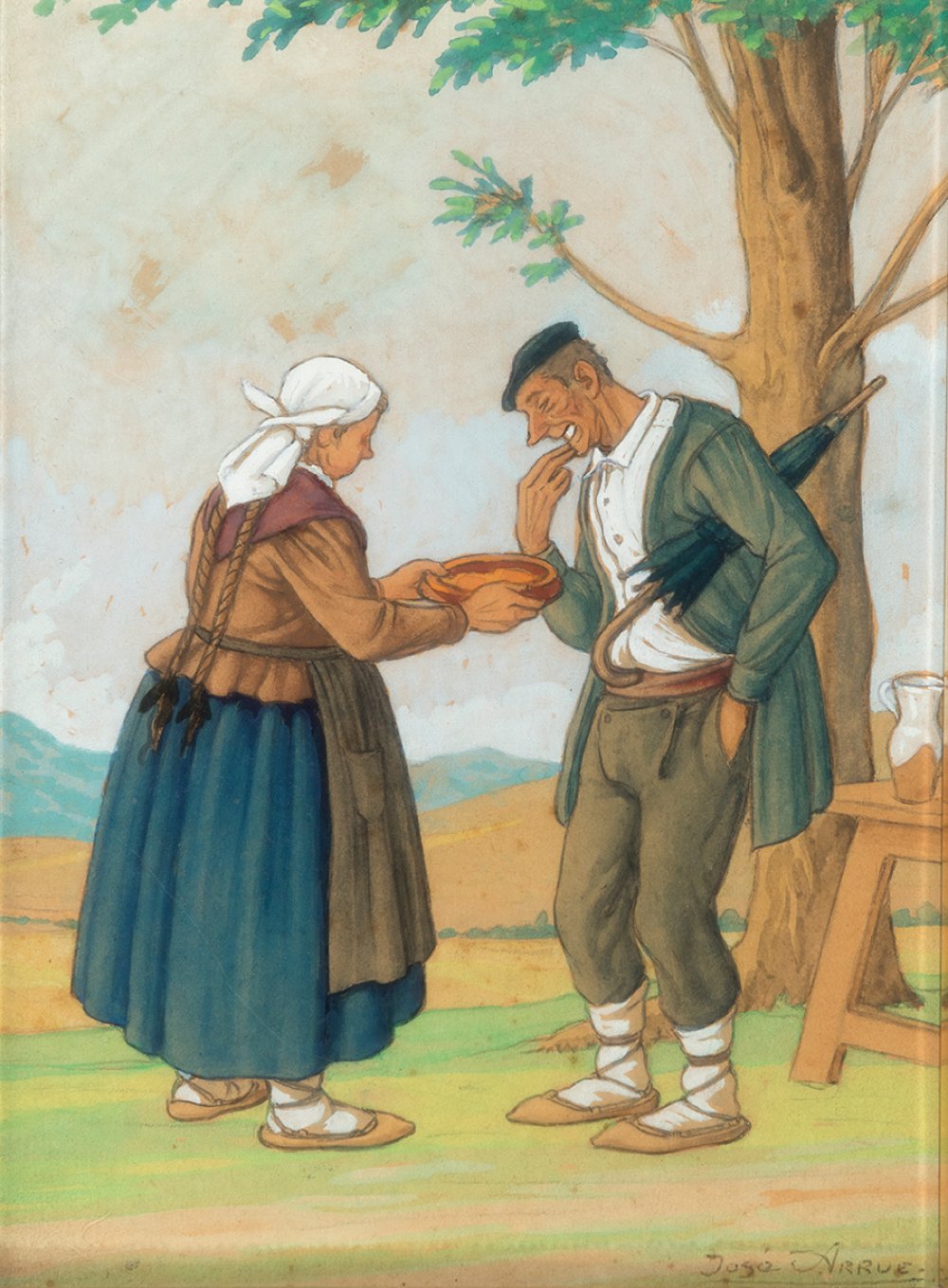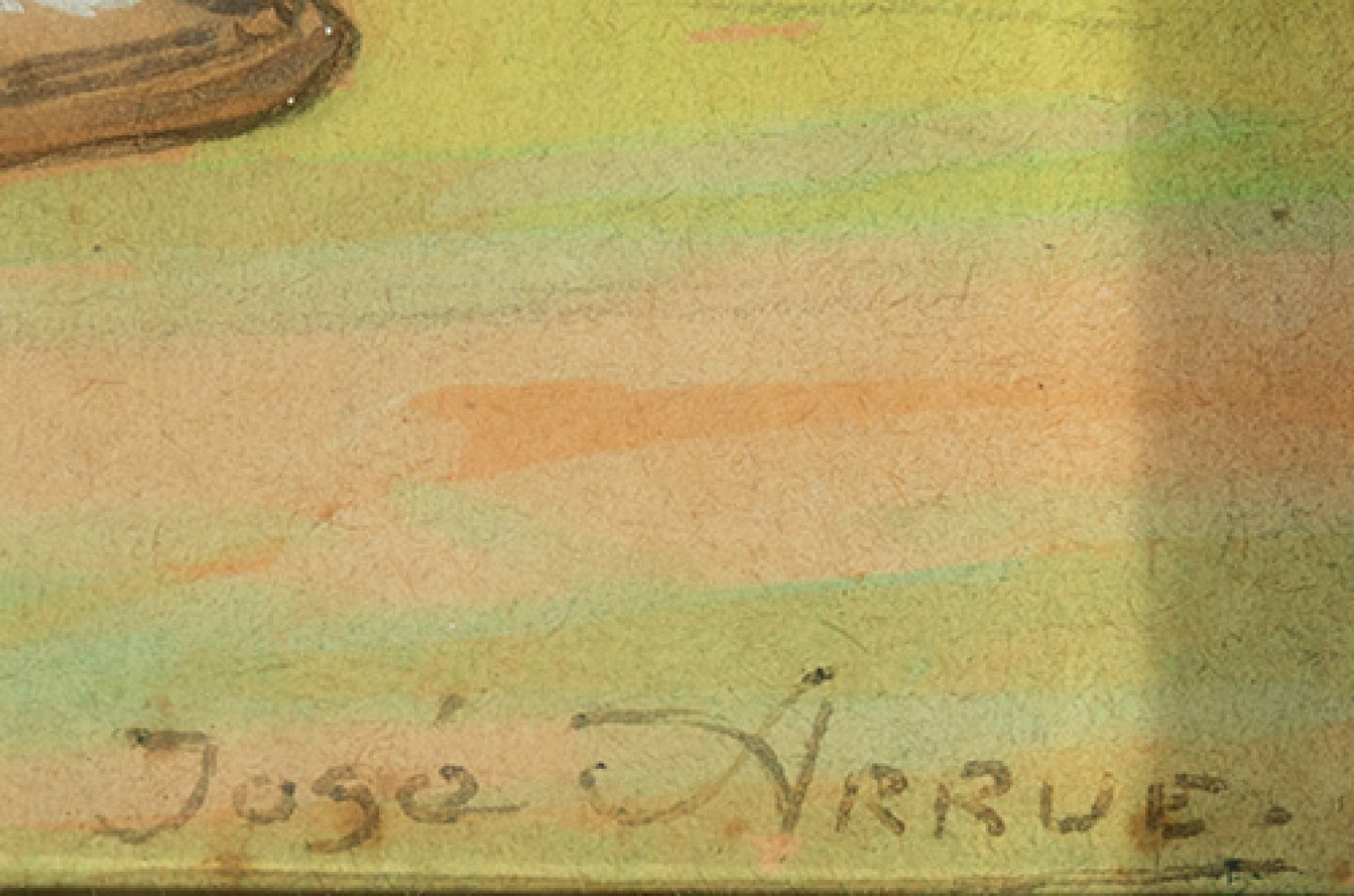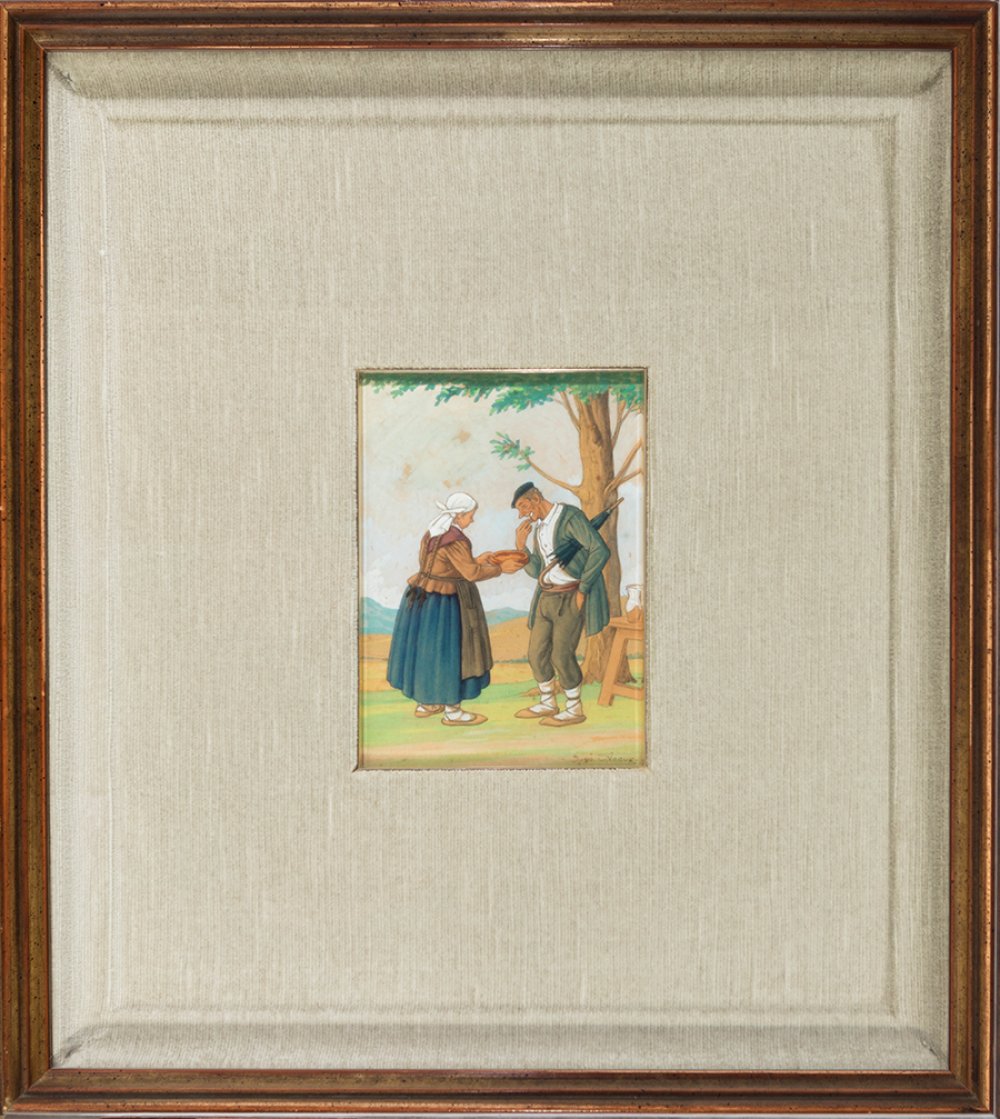6
JOSÉ ARRÚE VALLE (Bilbao, 1885 - Llodio, Álava, 1977)."Basque couple".Watercolour on paper.Signed in
1/3
Description
JOSÉ ARRÚE VALLE (Bilbao, 1885 - Llodio, Álava, 1977).
"Basque couple".
Watercolour on paper.
Signed in the lower right corner.
Size: 20 x 16 cm; 53 x 48 cm (frame).
José Arrué was an outstanding painter of Basque types, characterised with great intuition, as this fresh watercolour scene attests. Arrúe trained in Bilbao, and later extended his studies in Barcelona, Paris and Milan. In 1908 he returned to his native land and began to combine his artistic practice with teaching, teaching figure drawing at the Bilbao School of Arts and Crafts. That same year he collaborated in the founding of the magazine "El Coiteao". A year later, his love of bullfighting led him to wear the bullfighter's costume, and he even fought in eight bullfights. His presentation as a bullfighter took place in Bilbao on October 17th, and according to the reviews of the time he defended himself well. Around this time he began to make himself known, and held exhibitions of his work in Bilbao in 1911, 1915, 1920 and 1925. The following year, in 1926, Arrúe moved to Paris, where he continued to paint until finally appearing in Buenos Aires in the company of his brother Ramiro, also a painter. This exhibition, which opened on 10 July 1928, was held at the Sociedad de Amigos del Arte in the Argentinean capital, and its success was such that it became itinerant, continuing its staging in Cordoba, in the hall of the newspaper "La Razón", with which Arrúe would collaborate artistically for several years. Subsequently, the exhibition was also shown at the Moretti, Catelli and Mazzuchelli gallery in Montevideo, and ended its journey at the Salón Wicomb in Rosario, again in Argentina. During this trip, Arrúe took part in the Exhibition of Basque Artists held at the Gran Casino in San Sebastián on the occasion of the Great Basque Week, and was also awarded a prize for his poster in the 2nd International Labour Competition. Also during these years, between 1926 and 1931, Arrúe collaborated in Madrid newspapers such as "El Sol", "Crisol" and "El Liberal", working in the comics section. He also worked in advertising for savings banks, produced posters for Bilbao's Semana Grande, illustrated cards with Basque types and landscapes and also books such as "Guipúzcoa. Lecturas", by Bonifacio Arrabal (1930), "Ansonekoa" by José E. de Arriaga (1931), "Viaje a Navarra durante la insurrección vasca (1835)" (1933) and "Los esclavos felices", also by Arriaga (1935). He was also an active participant in the Basque cultural scene. From 1912, the year of the first exhibition of the Association of Basque Artists, Arrúe took part in numerous events and exhibitions held by the association, even exhibiting individually in its hall in 1931. He also contributed to its foundation, and held the posts of accountant, librarian and treasurer. In 1933 his works were included in the Association's last exhibition, held at the Emporium Galleries in Barcelona. In the 1930s he took part in the III Exhibition of Basque Artists, although three years later, in 1937, he was imprisoned. Now free, in 1940 he settled in Areta (Llodio), living a retired life from then on. However, he continued to exhibit his work in the following years, taking part in group exhibitions of Basque artists, and in 1973 a retrospective exhibition of his work was held in the Sala de Cultura of the Caja de Ahorros Provincial de Álava. He is currently represented in the Bilbao Fine Arts Museum, among other public and private collections.
"Basque couple".
Watercolour on paper.
Signed in the lower right corner.
Size: 20 x 16 cm; 53 x 48 cm (frame).
José Arrué was an outstanding painter of Basque types, characterised with great intuition, as this fresh watercolour scene attests. Arrúe trained in Bilbao, and later extended his studies in Barcelona, Paris and Milan. In 1908 he returned to his native land and began to combine his artistic practice with teaching, teaching figure drawing at the Bilbao School of Arts and Crafts. That same year he collaborated in the founding of the magazine "El Coiteao". A year later, his love of bullfighting led him to wear the bullfighter's costume, and he even fought in eight bullfights. His presentation as a bullfighter took place in Bilbao on October 17th, and according to the reviews of the time he defended himself well. Around this time he began to make himself known, and held exhibitions of his work in Bilbao in 1911, 1915, 1920 and 1925. The following year, in 1926, Arrúe moved to Paris, where he continued to paint until finally appearing in Buenos Aires in the company of his brother Ramiro, also a painter. This exhibition, which opened on 10 July 1928, was held at the Sociedad de Amigos del Arte in the Argentinean capital, and its success was such that it became itinerant, continuing its staging in Cordoba, in the hall of the newspaper "La Razón", with which Arrúe would collaborate artistically for several years. Subsequently, the exhibition was also shown at the Moretti, Catelli and Mazzuchelli gallery in Montevideo, and ended its journey at the Salón Wicomb in Rosario, again in Argentina. During this trip, Arrúe took part in the Exhibition of Basque Artists held at the Gran Casino in San Sebastián on the occasion of the Great Basque Week, and was also awarded a prize for his poster in the 2nd International Labour Competition. Also during these years, between 1926 and 1931, Arrúe collaborated in Madrid newspapers such as "El Sol", "Crisol" and "El Liberal", working in the comics section. He also worked in advertising for savings banks, produced posters for Bilbao's Semana Grande, illustrated cards with Basque types and landscapes and also books such as "Guipúzcoa. Lecturas", by Bonifacio Arrabal (1930), "Ansonekoa" by José E. de Arriaga (1931), "Viaje a Navarra durante la insurrección vasca (1835)" (1933) and "Los esclavos felices", also by Arriaga (1935). He was also an active participant in the Basque cultural scene. From 1912, the year of the first exhibition of the Association of Basque Artists, Arrúe took part in numerous events and exhibitions held by the association, even exhibiting individually in its hall in 1931. He also contributed to its foundation, and held the posts of accountant, librarian and treasurer. In 1933 his works were included in the Association's last exhibition, held at the Emporium Galleries in Barcelona. In the 1930s he took part in the III Exhibition of Basque Artists, although three years later, in 1937, he was imprisoned. Now free, in 1940 he settled in Areta (Llodio), living a retired life from then on. However, he continued to exhibit his work in the following years, taking part in group exhibitions of Basque artists, and in 1973 a retrospective exhibition of his work was held in the Sala de Cultura of the Caja de Ahorros Provincial de Álava. He is currently represented in the Bilbao Fine Arts Museum, among other public and private collections.
Auction Details
Shipping
T&Cs & Important Info
Ask seller a question
JOSÉ ARRÚE VALLE (Bilbao, 1885 - Llodio, Álava, 1977).
"Basque couple".
Watercolour on paper.
Signed in the lower right corner.
Size: 20 x 16 cm; 53 x 48 cm (frame).
José Arrué was an outstanding painter of Basque types, characterised with great intuition, as this fresh watercolour scene attests. Arrúe trained in Bilbao, and later extended his studies in Barcelona, Paris and Milan. In 1908 he returned to his native land and began to combine his artistic practice with teaching, teaching figure drawing at the Bilbao School of Arts and Crafts. That same year he collaborated in the founding of the magazine "El Coiteao". A year later, his love of bullfighting led him to wear the bullfighter's costume, and he even fought in eight bullfights. His presentation as a bullfighter took place in Bilbao on October 17th, and according to the reviews of the time he defended himself well. Around this time he began to make himself known, and held exhibitions of his work in Bilbao in 1911, 1915, 1920 and 1925. The following year, in 1926, Arrúe moved to Paris, where he continued to paint until finally appearing in Buenos Aires in the company of his brother Ramiro, also a painter. This exhibition, which opened on 10 July 1928, was held at the Sociedad de Amigos del Arte in the Argentinean capital, and its success was such that it became itinerant, continuing its staging in Cordoba, in the hall of the newspaper "La Razón", with which Arrúe would collaborate artistically for several years. Subsequently, the exhibition was also shown at the Moretti, Catelli and Mazzuchelli gallery in Montevideo, and ended its journey at the Salón Wicomb in Rosario, again in Argentina. During this trip, Arrúe took part in the Exhibition of Basque Artists held at the Gran Casino in San Sebastián on the occasion of the Great Basque Week, and was also awarded a prize for his poster in the 2nd International Labour Competition. Also during these years, between 1926 and 1931, Arrúe collaborated in Madrid newspapers such as "El Sol", "Crisol" and "El Liberal", working in the comics section. He also worked in advertising for savings banks, produced posters for Bilbao's Semana Grande, illustrated cards with Basque types and landscapes and also books such as "Guipúzcoa. Lecturas", by Bonifacio Arrabal (1930), "Ansonekoa" by José E. de Arriaga (1931), "Viaje a Navarra durante la insurrección vasca (1835)" (1933) and "Los esclavos felices", also by Arriaga (1935). He was also an active participant in the Basque cultural scene. From 1912, the year of the first exhibition of the Association of Basque Artists, Arrúe took part in numerous events and exhibitions held by the association, even exhibiting individually in its hall in 1931. He also contributed to its foundation, and held the posts of accountant, librarian and treasurer. In 1933 his works were included in the Association's last exhibition, held at the Emporium Galleries in Barcelona. In the 1930s he took part in the III Exhibition of Basque Artists, although three years later, in 1937, he was imprisoned. Now free, in 1940 he settled in Areta (Llodio), living a retired life from then on. However, he continued to exhibit his work in the following years, taking part in group exhibitions of Basque artists, and in 1973 a retrospective exhibition of his work was held in the Sala de Cultura of the Caja de Ahorros Provincial de Álava. He is currently represented in the Bilbao Fine Arts Museum, among other public and private collections.
"Basque couple".
Watercolour on paper.
Signed in the lower right corner.
Size: 20 x 16 cm; 53 x 48 cm (frame).
José Arrué was an outstanding painter of Basque types, characterised with great intuition, as this fresh watercolour scene attests. Arrúe trained in Bilbao, and later extended his studies in Barcelona, Paris and Milan. In 1908 he returned to his native land and began to combine his artistic practice with teaching, teaching figure drawing at the Bilbao School of Arts and Crafts. That same year he collaborated in the founding of the magazine "El Coiteao". A year later, his love of bullfighting led him to wear the bullfighter's costume, and he even fought in eight bullfights. His presentation as a bullfighter took place in Bilbao on October 17th, and according to the reviews of the time he defended himself well. Around this time he began to make himself known, and held exhibitions of his work in Bilbao in 1911, 1915, 1920 and 1925. The following year, in 1926, Arrúe moved to Paris, where he continued to paint until finally appearing in Buenos Aires in the company of his brother Ramiro, also a painter. This exhibition, which opened on 10 July 1928, was held at the Sociedad de Amigos del Arte in the Argentinean capital, and its success was such that it became itinerant, continuing its staging in Cordoba, in the hall of the newspaper "La Razón", with which Arrúe would collaborate artistically for several years. Subsequently, the exhibition was also shown at the Moretti, Catelli and Mazzuchelli gallery in Montevideo, and ended its journey at the Salón Wicomb in Rosario, again in Argentina. During this trip, Arrúe took part in the Exhibition of Basque Artists held at the Gran Casino in San Sebastián on the occasion of the Great Basque Week, and was also awarded a prize for his poster in the 2nd International Labour Competition. Also during these years, between 1926 and 1931, Arrúe collaborated in Madrid newspapers such as "El Sol", "Crisol" and "El Liberal", working in the comics section. He also worked in advertising for savings banks, produced posters for Bilbao's Semana Grande, illustrated cards with Basque types and landscapes and also books such as "Guipúzcoa. Lecturas", by Bonifacio Arrabal (1930), "Ansonekoa" by José E. de Arriaga (1931), "Viaje a Navarra durante la insurrección vasca (1835)" (1933) and "Los esclavos felices", also by Arriaga (1935). He was also an active participant in the Basque cultural scene. From 1912, the year of the first exhibition of the Association of Basque Artists, Arrúe took part in numerous events and exhibitions held by the association, even exhibiting individually in its hall in 1931. He also contributed to its foundation, and held the posts of accountant, librarian and treasurer. In 1933 his works were included in the Association's last exhibition, held at the Emporium Galleries in Barcelona. In the 1930s he took part in the III Exhibition of Basque Artists, although three years later, in 1937, he was imprisoned. Now free, in 1940 he settled in Areta (Llodio), living a retired life from then on. However, he continued to exhibit his work in the following years, taking part in group exhibitions of Basque artists, and in 1973 a retrospective exhibition of his work was held in the Sala de Cultura of the Caja de Ahorros Provincial de Álava. He is currently represented in the Bilbao Fine Arts Museum, among other public and private collections.
31st August -19th & 20th Century Arts
Sale Date(s)
Venue Address
Aragón 346, Barcelona
Calle Velázquez 7, Madrid
Carrer de Cirilo Amorós 55, Valencia
Barcelona
08009
Spain
General delivery information available from the auctioneer
Setdart offers Worldwide shipping
PICK UP IN ROOM: You can come and pick up your lots in our offices (Barcelona, Madrid or Valencia). At the moment of the withdrawal, you will be able to accept the current conditions of the lot by means of a document that you will sign.
YOU CAN SEND ANOTHER PERSON TO PICK UP: This person must present a signed authorization that you can find in our web page by accessing from BUY AT SETDART- LOGISTICS-DOWNLOAD AUTHORIZATION DOCUMENT. You can also send an e-mail with the requested data in AUTHORIZATION DOCUMENT to admin@setdart.com
Important Information
25% buyer´s premium
21% buyer´s premium at www.setdart.com









